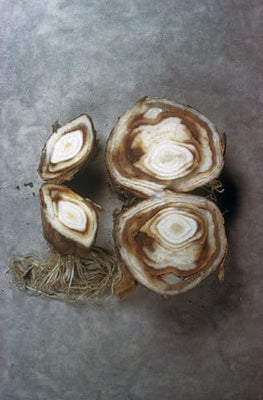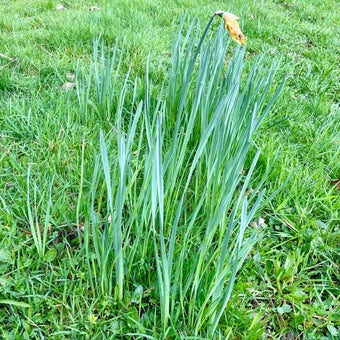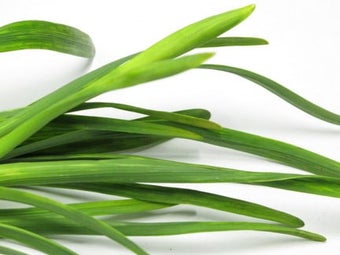
Quick facts
Common name - Stem and bulb nematode or eelworm
Scientific name - Ditylenchus dipsaci
Plants affected - Flower bulbs (Narcissus, tulips, hyacinths), Vegetables (onions, garlic, carrots, parsnip, beans) and other plants including hydrangea and phlox
Main symptoms - Swelling bulbs, stunted and distorted growth, malformed leaves, seedlings dying
Caused by - A microscopic plant parasitic nematode
Timing - Symptoms more visible at end of the growing season, can be active all year round
What are stem and bulb nematodes?
Nematodes are multicellular, unsegmented, worm-like animals. Stem and bulb nematode feeds within plant tissue often causing distortion and dieback.
The Nematoda is a very diverse phylum of animals, there are more than 25,000 described species. Their adaptability to almost every habitat including soil, freshwater, marine and all climatic zones is what makes them so successful. Nematodes are essential to ecosystems including the garden; a large proportion help break down and recycle organic material these are free-living nematodes other species are obligate parasites (cannot complete lifecycle without their host) of plants and animals.
Stem and bulb nematode feeds within soft plant tissue (parenchymatous) sometimes in leaves but mostly in stems, and tubers. Slowly their feeding breaks down cell walls allowing them to invade fresh tissue, a habit known as migratory endoparasitism. This causes cell death and distorted growth. These nematodes can affect a broad range of host plants and they proliferate in wet, cool conditions and have been reported in the UK and throughout Europe.
Stem and bulb nematodes are particularly difficult to recognise as they live inside host tissues and are too small to be seen without the aid of a microscope.
This nematode only lives in living plant tissue. Consequently, it has evolved intriguing ways to survive desiccation. Once infected plant material dies and dries out the nematodes will go into a state of anhydrobiosis, a process in which an organism becomes almost completely dry and until living conditions improve. This mostly happens in a barren field or allotment where bulbs are left to dry and not so much in a garden environment with many alternative host plants present.
Inside the infected plant tissue, the nematodes hatch from an egg as a second stage juvenile and continue to feed and molt into a third stage and later a fourth stage juvenile. It is the fourth stage larval phase that will exit plant tissue in search of a new host. The infectious fourth stage juvenile enters emerging plant tissue below ground or in unfavourable conditions go into a state of anhydrobiosis. Once in the host plant, they destructively feed, molt into adults and produce eggs. At a temperature of 15⁰C their life cycle can be completed in 21 days.
The active movement of these nematodes are limited but in the anhydrobiotic (dormant) state they can be readily spread in plant material such as bulbs, plant debris or contaminated garden tools.
Symptoms
The symptoms described below can also be typical of some nutrient deficiencies and disease. Confirming stem and bulb nematodes are present usually requires laboratory examination of plant material. Please use our online service via My RHS to send us photographs and find out how to submit samples as we have advice staff and scientists working to help with your questions.
There are several different strains or biotypes of stem and bulb nematode. Morphologically they appear similar and can only be distinguished by DNA sequencing and the range of host plants. For example, in Britain the strain feeding on tulips will also affect Narcissus (daffodils) but another strain readily found on Narcissus will not attack tulips.
Symptoms on vegetables
Members of the Allium family (onions, shallots, chives, garlic and leeks) tend to swell and distort. This is sometimes referred to as 'onion blout', ultimately the rot, crack and die.
In rhubarb, carrots and parsnips, the crown and leaf bases swell, rot and eventually split.
French and runner beans suffer from swollen stems which blister and turn brown, growth can be stunted and leaves will grow in bunches.
Symptoms on ornamentals
On herbaceous ornamentals, such as phlox, growth is stunted and foliage tends to die back, leaves turn yellow later brown, twisting and distorting.
In infected bulbous plants, such as tulips and daffodils, the above ground growth will produce stunted and distorted foliage that has a yellowish colour. Small pale yellowish swellings or speckles develop on the underside of leaves. These speckled swellings are more prominent before flowering and can easily be felt when the leaf is run between finger and thumb. In the bulbs the inner scales are usually more severely attacked than the outer scales. The bulbs become soft and brown and eventually rots. If an infested bulb is cut in half transversely, the feeding damage within the bulb can be seen as a series of brown rings or arcs. There is no sign of a maggot, as would be the case if they were affected by narcissus bulb fly.
In large plantings of daffodils the area of dead and distorted plants gradually increases each year as the nematode spreads from plant to plant.
Note that where many daffodils fail to appear, often in the second year after planting, this is more likely to be due to a fungal disease known as narcissus basal rot.
Management
Cultural methods can be used to reduce nematode populations and minimise damage.
Purchase nematode free plant material
Avoid introducing stem and bulb nematode and other bulb problems into your garden by buying firm, good quality from reputable suppliers.
Good sanitation practices in the garden
Once the presence of stem and bulb nematode has been confirmed, dig out any plant material showing signs of damage and also other apparently healthy host plants within a one metre radius. Removed bulbs and foliage should be treated as diseased material and not be disposed of in a garden heap.
Leave fallow
If possible leave soil where namatodes have been a problem bare for at least three years, without host plants the nematodes should die out. Longer periods may be needed if you have a loam soil. During this time continuously remove weeds that could be potential host plants.
Hot water treatment:
Hot water treatment can destroy the nematodes within the bulb. This method was first developed in 1916 by James Kirkham Ramsbottom a horticulture student at RHS Wisley and it saved the daffodil industry. Nematodes in bulbs can be killed by immersing the bulbs in water held at 44.5°C (112°F) for three hours. However, this is a difficult procedure without professional equipment, and so usually limited to commercial production. Too much heat will damage the bulbs, while too little will allow the nematodes to survive. An insulated water tank with thermostatic controls is needed to maintain the correct temperature. After treatment, the bulbs should be planted in a different part of the garden with soil where there has not previously been a nematode problem.





